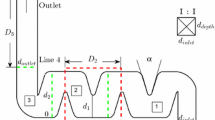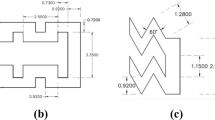Abstract
The baffle-fitted labyrinth-channel is largely used in drip irrigation systems. The existing baffles, which play an important role for generating head losses and ensure the flow regulation on the irrigation network, produce vorticity regions where the velocity is low or equal to zero. These vortices are likely to favor the deposition of particles or biochemical development causing dripper clogging which drastically reduces its performance. Flow topology in the dripper labyrinth-channel must be described to analyze dripper clogging sensibility and the effect on irrigation efficiency. Also, a question remains about the regime of this low Reynolds number flow. In the present study, the flow is characterized experimentally by micro-particle image velocimetry (micro-PIV) technique on ten-pattern repeating baffles used in drip irrigation dripper. Square cross-section is of about 1.4 mm\(^2\). Studied inlet Reynolds number varies from 345 to 690, which is equivalent to 1.4–2.8 l h\(^{-1}\). The mean velocity distribution and turbulence quantities within the labyrinth-channel flow are presented and discussed in this paper. The results underline that flow regime is turbulent and non-isotropic.
Graphical abstract




















Similar content being viewed by others
References
Ali AAM (2013) Anti-clogging drip irrigation dripper design innovation. Eur Int J Sci Technol 2(8):154–164
Al-Muhammad J (2016) Flow in millimetric-channel: numerical and experimental study. PhD Thesis, IRSTEA, Ecole Centrale Marseille, p 240
Al-Muhammad J, Tomas S, Anselmet F (2016) Modeling a weak turbulent flow in a narrow and wavy channel: case of micro-irrigation. Irrig Sci 34(5):361–377
Beadie G, Brindza M, Flynn RA, Rosenberg A, Shirk JS (2015) Refractive index measurements of poly(methyl methacrylate) (PMMA) from 0.4–1.6 \(\mu\)m. Appl Opt 54:F139–F143
Christensen KT (2004) The influence of peak-locking errors on turbulence statistics computed from PIV ensembles. Exp Fluids 36:484–497
Date AW (2005) Introduction to computational fluid dynamics. Cambridge University Press, New-York
Dazhuang Y, Peiling Y, Shumei R, Yunkai L, Tingwu X (2007) Numerical study on flow property in dentate path of drip drippers. N Z J Agric Res 50:705–712
Goldberg D, Gornat B, Rimon D (1976) Drip irrigation: principles, design, and agricultural practices. Scientific Publications, Israel
Hale G, Querry M (1973) Optical constants of water in the 200-nm to 200-\(\mu\) m wavelength region. Appl Opt 12:555–563
Howell TA (2003) Irrigation efficiency. In: Encyclopedia of water science. Marcel Dekker, Inc, New York, p 1076. https://doi.org/10.1081/E-EWS120010252. http://www.researchgate.net/publication/43256707
Hsiao TC, Steduto P, Fereres EA (2007) Systematic and quantitative approach to improve water use efficiency in agriculture. Irrig Sci 25:209–231
Jenkins FA, White HE (1957) Fundamentals of optics 3rd edn. McGraw-Hill, New York
Kumar BVKV, Hassebrook L (1990) Performance measures for correlation filters. Appl Opt 29(20):2997–3006
Lamm FR, Ayars JE, Nakayama FS (2007) Microirrigation for crop production–design, operation and management. Elsevier, Oxford, p 608
Lazarova V, Bahri A (2015) Water reuse for irrigation—agriculture, landscapes, and turf grass. CRC Press, Boca Raton
Li YK, Yang PL, Xu TW, Ren SM, Lin XC, Wei RJ, Xu HB (2008) CFD and digital particle tracking to assess flow characteristics in the labyrinth flow path of a drip irrigation emitter. Irrig Sci 26:427–438
Liu HS, Li YK, Liu YZ, Yang PL, Ren SM, Wei RJ, Xu HB (2010) Flow characteristics in energy dissipation units of labyrinth path in the drip irrigation drippers with DPIV technology. J Hydrody Ser B 22(1):137–145
Lu L, Sick V (2013) High-speed particle image velocimetry near surfaces. J Vis Exp 76:50559. https://doi.org/10.3791/50559
Meinhart CD, Wereley ST (2003) The theory of diffraction-limited resolution in microparticle image velocimetry. Meas Sci Technol 14:1047–1053
Nakayama FS, Bucks DA (1991) Water quality in drip/trickle irrigation: a review. Irrig Sci 12:187–192
Nishimura T, Ohori Y, Kawamura Y (1984) Flow characteristics in a channel with symmetric wavy wall for steady flow. J Chem Eng Jpn 17:466–471
Olsen M, Adrian R (2000) Exp Fluids 29(Suppl 1):S166–S174
Oron G, Campos C, Gillerman L, Salgot M (1999) Wastewater treatment, renovation and reuse for agricultural irrigation in small communities. Agric Water Manag 38:223–234
Overmars EFJ, Warncke NGW, Poelma C, Westerweel J (2010) Bias errors in PIV: the pixel locking effect revisited. 15th international symposium on applications of laser techniques to fluid mechanics Lisbon, Portugal, p 10
Philipova N, Nikolov N, Pichurov G, Markov (2009) A mathematical model of dripper discharge depending on geometric parameters of drip dripper labyrinth channel. In: Proceedings of the 11th national congress on theoretical and applied mechanics, 2–5 Sept 2009, Borovets, Bulgaria (CD-ROM), pp 1–6
Raffel M, Willert C, Kompenhans J (1998) Particle image velocimtry. Springer, Berlin
Wei Q, Shi Y, Dong Q, Lu Q, Huang S (2006) Study on hydraulic performance of drip drippers by computational fluid dynamics. Agric Water Manag 84:30–136
Wei Z, Cao M, Liu X, Tang Y, Lu B (2012) Flow behaviour analysis and experimental investigation for dripper micro-channels. Chin J Mech Eng 25:729–737
Wereley ST, Meinhart CD, Gray MHB (1999) Depth effects in volume illuminated particle image velocimetry. Third international workshop on particle image velocimetry, Santa Barbara, CA, USA
Westerweel J (2000) Theoretical analysis of the measurement precision in particle image velocimetry. Exp Fluids 29(Suppl 1):S003–S012
Wu D, Li Y, Liu HS, Yang PL, Sun HS, Liu YZ (2013) Simulation of the flow characteristics of a drip irrigation dripper with large eddy methods. Math Comput Model 58(3–4):497–506
Yavuz Y, Demirel K, Erken O, Bahar E, Etoz M (2010) Emitter clogging and effects on drip irrigation systems performances. Afr J Agric Res 5(7):532–538
Zhang J, Zhao W, Wei Z, Tang Y, Lu B (2007) Numerical investigation of the clogging mechanism in labyrinth channel of the dripper. Int J Numer Methods Eng 70:1598–1612
Zhang J, Zhao W, Tang Y, Lu B (2010) Anti-clogging performance evaluation and parameterized design of drippers with labyrinth channels. Comput Electron Agric 74(1):59–65
Acknowledgements
This work has been funded by the seventh Framework Programme FP7-KBBE-2012-6:Water4Crops and Aleppo university in partnership with the laboratories IRSTEA (Institut national de recherche en sciences et technologies pour l’environnement et l’agricult- ure) and IRPHE (Institut de Recherche sur les Phénomènes Hors Equilibre). The authors are grateful to Jean-Jacques Lasserre from Dantec Dynamics company.
Author information
Authors and Affiliations
Corresponding author
Additional information
Publisher's Note
Springer Nature remains neutral with regard to jurisdictional claims in published maps and institutional affiliations.
Appendices
Appendix 1: Uncertainly analysis
1.1 Peak locking
The peak-locking effect is due to the sensor geometry in digital cameras. This phenomenon occurs when particle images are much smaller than the pixel size, so that the displacement tends to be biased towards discrete pixel values (Westerweel 2000). Peak-locking significantly reduces the accuracy of micro-PIV measurements although the effects on the mean velocities may be within acceptable limits. Indeed, the mean velocities are the only statistics that are insensitive to peak locking as it was found by Christensen (2004). The peak-locking effect can lead to awkward results for instantaneous spatial derivative data such as velocity gradient and also for turbulent velocity fluctuations. The easiest way to analyze this phenomenon is to plot an histogram of the fractional part of velocity components (displacements) which is between \(-\,0.5\) and \(+\,0.5\) pixel units. In the present study, the pixel size, due to the magnification, is equivalent to 1.074 \(\upmu\)m, which is close to the particles diameter. The histograms of displacements are presented in Fig. 20. The degree of peak locking can be quantified as:
where \(N_{\text {min}}\) (minimum of \(\%\)) and \(N_{\text {max}}\) (maximum of \(\%\)) are the lowest and highest percent of counts in the fractional histogram. Hence, if \(C=0\), this indicates the absence of peak-locking, whereas \(C=1\) indicates very strong peak locking. Four levels of peak-locking can be distinguished (Overmars et al. 2010):
-
\(C<0.2\), virtually no peak-locking occurs,
-
\(0.2<C<0.4\) mild peak-locking occurs,
-
\(0.4<C<0.6\) strong peak-locking occurs,
-
\(C>0.6\) severe peak-locking.
1.2 Signal-to-noise ratio (SNR)
The choice of the optimal diameter for seeding particles is a compromise between an adequate tracer response of the particles in the fluid, which requires small diameters, and a high signal-to-noise ratio (SNR) of the scattered light signal, which requires large diameters. The cross-correlation SNR is based on the measure of the primary peak ratio (PPR), namely the ratio between the highest correlation peak and the second tallest peak (Kumar and Hassebrook 1990). The optical properties may be deteriorated when choosing 1 \(\upmu\)m diameter, even though there is no peak-locking effect which could induce erroneous estimates for mean velocities and fluctuating velocity second-order moments. In practice, for 1 \(\upmu\)m diameter, the SNR from the fourth baffle is less than 4, which is the threshold value for correct detection. Therefore, it is not possible to use the 1 \(\upmu\)m particles to conduct the micro-PIV experiments for baffles farther than the third one. The labyrinth-channel prototype is illuminated by the right side where \(x> 0\) (Fig. 1c). As a consequence, the laser light-sheet is more diffused by the 1-\(\upmu\)m particles and even more when the laser light-sheet moves deeper into the labyrinth-channel.
Appendix 2: Data processing
See Fig. 21.
Rights and permissions
About this article
Cite this article
Al-Muhammad, J., Tomas, S., Ait-Mouheb, N. et al. Micro-PIV characterization of the flow in a milli-labyrinth-channel used in drip irrigation. Exp Fluids 59, 181 (2018). https://doi.org/10.1007/s00348-018-2633-x
Received:
Revised:
Accepted:
Published:
DOI: https://doi.org/10.1007/s00348-018-2633-x






